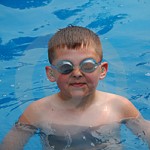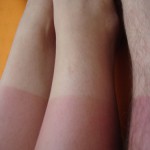by Michelle Sutton-Kerchner
Don’t lose your cool this summer because of seasonal pests. Skeeter syndrome, sunburn, swimmer’s ear, and other annoyances don’t belong on your vacation. Here’s how to deal with these sometimes unavoidable intruders …
Swimmer’s Ear
Water workouts, body surfing, and splash sessions with your tot are great fun. However, one too many waves of water in the ear can lead to a painful condition called swimmer’s ear (or “otitis externa” as per the poster label in the pediatrician’s office).
This ear canal infection occurs when water activity floods the ear canal with excess moisture. The natural waxy barrier that protects the ear from harmful substances and wards off bacteria becomes overwhelmed. An infection ensues. On a rare occasion, swimmer’s ear can be caused by a fungi or virus. However, most likely, it was one too many games of water volleyball or Marco Polo.
Typical symptoms include ear itching, discomfort, and odorless fluid drainage. Left untreated, symptoms worsen and become painful, pus can be present, and hearing impaired. Severe cases may cause extreme pain, swollen lymph nodes, and irritation in the outer ear.
Once diagnosed, a physician often cleans out the infected ear and prescribes antibiotic drops. The drops usually eliminate pain a day after first administered, with the infection clearing in a week. Avoid submerging your head under water until the infection is cleared. As a precaution, a cotton ball should be inserted in the infected ear when in water environments, including the bath or shower.
A Drop of Prevention
To help prevent swimmer’s ear, a solution of water and isopropyl alcohol can be dropped into each ear after swimming or when water is detected in the ear. This helps absorb the moisture and eliminate buildup of bacteria. You can also purchase over-the-counter ear drops for such occasions. Consider purchasing a mini ear dryer to keep with your fitness gear. It’s lightweight, easy to use, and quick to eliminate annoying water in your ears after a dip. A better alternative to jumping on one foot and banging the side of one’s tilted head.

Silicone earplugs also may reduce the risk of swimmer’s ear, and allow you to train during treatment of an infection (with a physician’s approval). If you have a punctured eardrum, avoid self-treatment of any kind.
Don’t swim in stagnant bodies of water and other areas with high bacteria levels, such as a suspicious kiddie pool.
This condition is most common in children and young adults. It’s also prevalent among those with excessive ear wax, and swimmers with allergic conditions, such as eczema, seasonal allergies, and asthma.
Mosquito Bites
Think of a mosquito bite as the female mosquito’s attempt at following her species’ food pyramid (or “food plate” as of date). The female mosquito requires a blood meal to produce eggs. In meeting this requirement, mosquito saliva proteins are injected into the host, which usually trigger an immune reaction in the recipient. These can include allergic reactions, including Skeeter Syndrome. (Yes, that’s an official name.) Typically, the body reacts with swelling and itching, either immediate or delayed, around the bitten area.
Blistering rashes, bruises, or large areas of swelling at the bite site indicate an official allergy to mosquito bites. Those who suffer extremely large areas of swelling after a bite, such as an entire limb, are considered to have Skeeter Syndrome.
Rare but severe reactions include body-wide swelling and hives, anaphylaxis (a life-threatening shock to the body’s system), or asthmatic reactions. These symptoms, which usually onset immediately, should be treated promptly via 911 or a hospital trip. Speak with your physician about use of a self-injectable form of epinephrine (much as you would treat a venom allergy to an insect sting) or rescue inhaler should such incident occur.
Certain individuals are more prone to a mosquito allergy:
- Those who partake in outdoor exercise routines. Another reason to seek the Center’s shelter for your summer workouts. (As if the 100-degree June days weren’t enough!)
- Outdoor workers, including camp counselors and those in wooded areas.
- Those with a low natural immunity to mosquitoes, including children (who haven’t been on earth long enough to build up a tolerance). Newcomers to an area also are at risk. They have not yet been exposed to local mosquito types. Keep this in mind during any vacation travel this summer.
- Individuals with immunodeficiencies, including AIDS or some types of cancer.
Mosquito-Proof Yourself
You can’t drape yourself in mosquito netting all season. However, there are some simple precautions you can take to avoid The Bite:
- Avoid swampy areas or tall grasses.
- Remove stagnant water or treat it with chemicals. Mosquitoes admire that bird bath you have as much as the birds.
- Limit physical exertion when outdoors, including strenuous exercise. Body odor, fragrance, skin temperature, and carbon dioxide production are an aphrodisiac to these critters. Take your workout to the Center.
- Use FDA-approved bug repellant on skin and clothing. For specifics on use, see: www.fda.gov.
Treatment
For the average mosquito bite, treat with a topical antiseptic (try one with a numbing agent) or corticosteroid cream. The latter should be used sparingly as frequent usage can cause a worse reaction to future bites.
Those with mosquito allergy may consider taking an oral antihistamine prior to mosquito-prevalent situations (such as firework viewings, night swims, and hiking). The drug cetirizine has been shown to reduce reactions to mosquito bites when taken prior to exposure.
The good news: The more bites you get, the more your reaction to them will diminish over time. Think of your next mosquito bite as (yet another) inoculation.
For information on tick bites, which can have long-term health effects, visit: www.cdc.gov/lyme/prev.
Sunburn

According to the CDC, up to 90 percent of melanomas, the most dangerous type of skin cancer, are caused by exposure to sunlight. Yet still, almost half of Americans don’t wear sunscreen. You pride yourself on a healthy lifestyle—feeding and exercising your body well. Protect your largest organ. Sunburn hurts immediately and in the long-term.
Prevention
You can’t avoid the sun—and who wants to. It’s important though to protect yourself from its harmful rays, even on cloudy days.
- Wear a hat that covers your face and prevents scalp burn.
- Only use sunglasses that block 100 percent UV light, even if you find a glam pair that are of a less percentage. Protection first; fashion, well, find a pair that looks cool and protects well.
- The American Academy of Dermatology recommends generous use of sunscreen with SPF of 30 or higher. Reapply every two hours, or more frequently if you are heavily perspiring or in water.
- T-shirts, especially white ones, offer very little protection. Consider clothing with built-in SPF, including swim shirts and shorts. These items are particularly convenient for small children, and are becoming more readily available.
If you wish to sport a South-of-France sun-kissed glow without leaving your New Jersey office, try sunless tanning products (usually sprays or creams). Consider it safe sunshine in a bottle. These self-tanners have come a long way. Some are even organic certified. You’ll get the beach look without aging your skin, predisposing yourself to cancer, and messing with the hot sand.
Sunless tanning pills are harmful and should not be used.
Treatment
Sunburn happens to the most diligent of us. We’ve all seen angry streaks of burnt skin under-reached by the applicant. Others can’t resist the allure of sunbathing, later suffering the crispy effects of their indulgence. There is no proven benefit to developing a “base tan” either naturally or through tanning beds. Any change to the skin’s color is a sign of UV-radiation damage, including through tanning salons.
When sunburned, apply cool compresses to the skin or soak in a cool bath. Note that you’ll chill up easily from your body’s hot surface. However, if accompanied by a high fever or severe pain, contact your physician. Other danger signs worthy of a call to the doc: blistering sunburn that covers most of the body or a burn that doesn’t improve after three days.
Apply aloe and non-alcohol-containing moisturizers. If possible, extract aloe from an actual aloe plant. Break open a leaf and rub the gel produced onto sunburned areas. Topical creams that contain anesthetics, such as benzocaine, are considered harmful and should be avoided. Over-the-counter pain relievers can ease the sting, especially when the light weight of bed sheets is a source of pain. Cover any blisters that develop to prevent irritation. Breaking them can slow healing and increase infection risks.

It would be remiss not to mention the trick of our grandmothers. Applying cooled tea bags to the skin is scientifically proven as helpful. Anyone who’s tried it can attest. Tea’s acidic properties are thought to relieve the pain from sunburn.
Steep black tea bags in water; the darker the tea water, the more effective. Dunk a washcloth into the cooled tea. Gently lay this cloth over the skin. Do not wipe or you’ll remove the tea. Allow tea to soak into your skin and dry naturally. Repeat two or three times daily, and notice a large improvement. If only a small area is sunburned, you can apply cooled tea bags directly to the skin. Tea does stain so avoid any contact with fabric. Or, not, if you wish to have a little reminder to slather on the screen next time.
Summer is almost here. Make it a safe, healthy one and enjoy.
Sources
“Mosquito Allergy: Reactions to Mosquito Bites,” by Daniel More at www.about.com.
“Natural Treatment for Swimmer’s Ear,” by Cathy Wong at www.about.com.
“Physician Helps Craft First Guidelines for Care, Diagnosis of Swimmer’s Ear,” UT Southwestern Medical Center at www.about.com.
“What’s the Most Effective Sunburn Treatment? When Does Sunburn Require Medical Attention?” by Lawrence E. Gibson at www.mayoclinic.com.
Image Credits
Shaded sun (introductory photo): www.flickr.com/photos/11120192@N07/1048268321/
Sunburn: www.flickr.com/photos/ctrlw/215569779/
Tea on beach: www.flickr.com/photos/dougfloyd/2652008801/
 Fitness & Wellness News Your Source for Fitness News, Wellness News, Health News, and Nutrition News!
Fitness & Wellness News Your Source for Fitness News, Wellness News, Health News, and Nutrition News!



